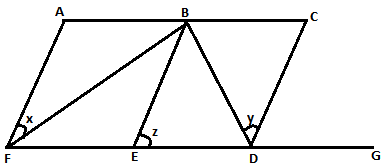12th Grade > Physics
CALCULUS MCQs
Total Questions : 29
| Page 2 of 3 pages
Answer: Option B. -> - xcosx - 2sinx
:
B
Using the Product Rule, we have f'(x)=xddx(cos x)+cos xddx(x)=-xsinx+cosx
To find f"(x) we differentiate f'(x):
f"(x)=ddx(-x sin x+cos x)=-xddx(sin x)+sin x ddx(-x)+ddx(cos x)
=-x cos x-sin x-sin x = -x cos x-2 sin x
:
B
Using the Product Rule, we have f'(x)=xddx(cos x)+cos xddx(x)=-xsinx+cosx
To find f"(x) we differentiate f'(x):
f"(x)=ddx(-x sin x+cos x)=-xddx(sin x)+sin x ddx(-x)+ddx(cos x)
=-x cos x-sin x-sin x = -x cos x-2 sin x
Answer: Option C. -> e2x2−1x+c
:
C
y=e2x+1x2
Integration both side w.r.t. 'x',
I=∫y.dx=∫⟮e2x+1x2⟯dx=e2x2+x−2+1−2+1+c[∵∫eax=eaxa+c]
I=e2x2−1x+c
:
C
y=e2x+1x2
Integration both side w.r.t. 'x',
I=∫y.dx=∫⟮e2x+1x2⟯dx=e2x2+x−2+1−2+1+c[∵∫eax=eaxa+c]
I=e2x2−1x+c
Answer: Option A. -> 2xcos(x2−4)
:
A
We now know how to differentiate sin x and x2−4, but how do we differentiate a composite like sin(x2−4)? the answer is, with the Chain Rule, which says that the derivatives of the composite of two differentiable fuctions is the product of their derivatives evaluated at appropriate points. The Chain Rule is probably the most used differentiation rule in mathematics.
Let u=x2−4
Then y=sin u
We know the differentiation of u w.r.t x and differentiation of y w.r.t u.
dudx=2x&dydu=cosu we can write dydx=dydu.dudx
dydx=(cosu).(2x)=2x.cos(x2−4)
:
A
We now know how to differentiate sin x and x2−4, but how do we differentiate a composite like sin(x2−4)? the answer is, with the Chain Rule, which says that the derivatives of the composite of two differentiable fuctions is the product of their derivatives evaluated at appropriate points. The Chain Rule is probably the most used differentiation rule in mathematics.
Let u=x2−4
Then y=sin u
We know the differentiation of u w.r.t x and differentiation of y w.r.t u.
dudx=2x&dydu=cosu we can write dydx=dydu.dudx
dydx=(cosu).(2x)=2x.cos(x2−4)
Answer: Option C. -> 2e4x[cos2x+2sin2x]
:
C
Here u=e4xv=sin2x, Differentiating both sides w.r.t. 'x'
dydx=ddx[e4xsin2x]
=e4xddx[sin2x]+sin2xddx[e4x](Using product rule)
=2e4xcos2x+sin2x4e4x=2e4x[cos2x+2sin2x]
:
C
Here u=e4xv=sin2x, Differentiating both sides w.r.t. 'x'
dydx=ddx[e4xsin2x]
=e4xddx[sin2x]+sin2xddx[e4x](Using product rule)
=2e4xcos2x+sin2x4e4x=2e4x[cos2x+2sin2x]
Answer: Option A. -> −GMmR
:
A
I=∫R∞GMmx2dx=GMm∫R∞dxx2=GMm[−1x]R∞
=GMm∣∣∣−1R+1∞∣∣∣=−GMmR
This expression represents the gravitational potential energy which is obtained by integrating GMm/x2 between the limits infinity (∞) and radius of the earth (R).
:
A
I=∫R∞GMmx2dx=GMm∫R∞dxx2=GMm[−1x]R∞
=GMm∣∣∣−1R+1∞∣∣∣=−GMmR
This expression represents the gravitational potential energy which is obtained by integrating GMm/x2 between the limits infinity (∞) and radius of the earth (R).
Answer: Option A. -> 1 + lnx
:
A
Here u=x, v=ln x
Differentiating both sides w.r.t. 'x', dydx=d[xlnx]dx
Using product rule = xd(lnx)dx+lnxd(x)dx=x1x+lnx.1=1+lnx
:
A
Here u=x, v=ln x
Differentiating both sides w.r.t. 'x', dydx=d[xlnx]dx
Using product rule = xd(lnx)dx+lnxd(x)dx=x1x+lnx.1=1+lnx
Answer: Option B. -> 72 unit2
:
B
The area can be divided into strips by drawing ordinates between x = 0 and x = 6 at a regular interval of dx. Consider the strip between the ordinates at x and x + dx. The height of this strip is y=x2. The area of this strip is dA = y dx= x2dx.
The total area of the shaded part is obtained by summing up these strip-areas with x varying from 0 to 6. Thus
A=6∫0x2dx
=[x33]60=216−03=72
:
B
The area can be divided into strips by drawing ordinates between x = 0 and x = 6 at a regular interval of dx. Consider the strip between the ordinates at x and x + dx. The height of this strip is y=x2. The area of this strip is dA = y dx= x2dx.
The total area of the shaded part is obtained by summing up these strip-areas with x varying from 0 to 6. Thus
A=6∫0x2dx
=[x33]60=216−03=72
Answer: Option A. -> x-(i); y-(iii); z-(iv)
:
A
i=i0e−tRC
i0R,Care constants
To find the rate of change of i
i.e.,
didt
⇒didt=−ioRCe−tRC
(x) at t=0
didt=−ioRC
(y) at t =RC
didt=−ioRCe−1=−ioRCe
(z) at t = 10RC
didt=−ioRCe−10RcRC=−ioRce10
:
A
i=i0e−tRC
i0R,Care constants
To find the rate of change of i
i.e.,
didt
⇒didt=−ioRCe−tRC
(x) at t=0
didt=−ioRC
(y) at t =RC
didt=−ioRCe−1=−ioRCe
(z) at t = 10RC
didt=−ioRCe−10RcRC=−ioRce10
Answer: Option D. -> None of these
:
D
I=∫100sec2(3x+6)dx
Let 3x+6=u
⇒3dx=du⇒dx=du3
I=∫sec2udu3
=13tan(u)+c
I=13tan(3x+6)100
13[tan36−tan6]
:
D
I=∫100sec2(3x+6)dx
Let 3x+6=u
⇒3dx=du⇒dx=du3
I=∫sec2udu3
=13tan(u)+c
I=13tan(3x+6)100
13[tan36−tan6]
Answer: Option C. -> sin(8x+6)8−cot(7x+5)7+6sec x + c
:
C
Let u=8x+6,dudx=8⇒dx=du8
t=7x+5,dtdx=7⇒dx=dt7
∫ydx=∫cosudu8+∫cosec2tdt7+6∫secxtanxdx
= sinu8+(−cott)7+6secx+c
= sin(8x+6)8−cot(7x+5)7+6secx+c
:
C
Let u=8x+6,dudx=8⇒dx=du8
t=7x+5,dtdx=7⇒dx=dt7
∫ydx=∫cosudu8+∫cosec2tdt7+6∫secxtanxdx
= sinu8+(−cott)7+6secx+c
= sin(8x+6)8−cot(7x+5)7+6secx+c

















